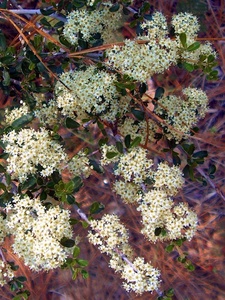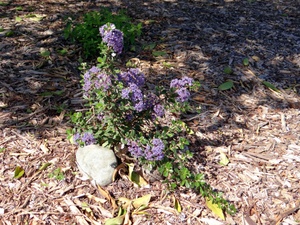 The deep blue flowers of Ceanothus 'Joyce Coulter' enliven a front yard. Photo by queerbychoice.
The deep blue flowers of Ceanothus 'Joyce Coulter' enliven a front yard. Photo by queerbychoice.
Ceanothus is a genus of about 55 evergreen and deciduous groundcovers, shrubs, and small trees growing wild throughout the U.S., Canada, and Mexico south to Guatemala. However, Ceanothus species are far more diverse in California than anywhere else. Many Ceanothus species are commonly called California Lilacs due to the visual resemblance of their flowers to lilacs. However, this genus is not closely related to European lilacs.
Ceanothus species are highly valued in the garden because they tend to be highly drought tolerant. However, a sure way to kill your ceanothus is to overwater it in the summer! Planting on a slope or atop a mound will help keep its roots happy. But even with the best of care, most Ceanothus species live only 15-20 years. 'Feltleaf Ceanothus' (Ceanothus arboreus, also known as the 'Tree Lilac' or 'Island Mt Lilac'), is the largest species and can live much longer.
Ceanothus species are also valued in the garden for the fact that the vast majority of them are evergreen and have large clusters of flowers, often in vivid shades of blue or purple, sometimes in white or pink. Most Ceanothus species can deal with sun and drought but are also happy with a bit of shade.
Most Ceanothus are frost tender and are mainly grown for their fluffy clusters of white, pink, or blue flowers. A Ceanothus in bloom is one of the sure signs that spring is on its way. Indeed, Ceanothus flowers are an important source of nectar and pollen for early bees, while small birds love the tiny seeds, and the stiff branches provide welcome cover for wildlife.
Ceanothus plants can be propagated by softwood cuttings in the summer.
Locally Native Species
Buckbrush (Ceanothus cuneatus) and deerbrush (Ceanothus integerrimus) are the only two species of Ceanothus that are native to Woodland. Four other species are native in other parts of Yolo County: wavyleaf Ceanothus (Ceanothus foliosus), maritime Ceanothus (Ceanothus maritimus), hairyleaf Ceanothus (Ceanothus oliganthus), and Mahala mat (Ceanothus prostratus). However, many other Ceanothus species and cultivars can be grown in Woodland. Ceanothus species are ranked 3, 4, or 5 on the Ogren Plant Allergy Scale, depending on their heights: groundcover species are fairly unlikely to cause hay fever, while tree-sized species are moderately likely to.
 Buckbrush (Ceanothus cuneatus) in the wild. Photo by queerbychoice.
Buckbrush (Ceanothus cuneatus) in the wild. Photo by queerbychoice. Maritime Ceanothus (Ceanothus maritimus 'Valley Violet') in a garden in Woodland. Photo by queerbychoice.
Maritime Ceanothus (Ceanothus maritimus 'Valley Violet') in a garden in Woodland. Photo by queerbychoice.


